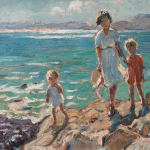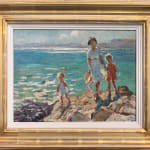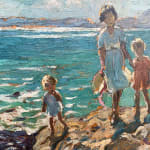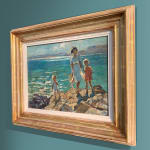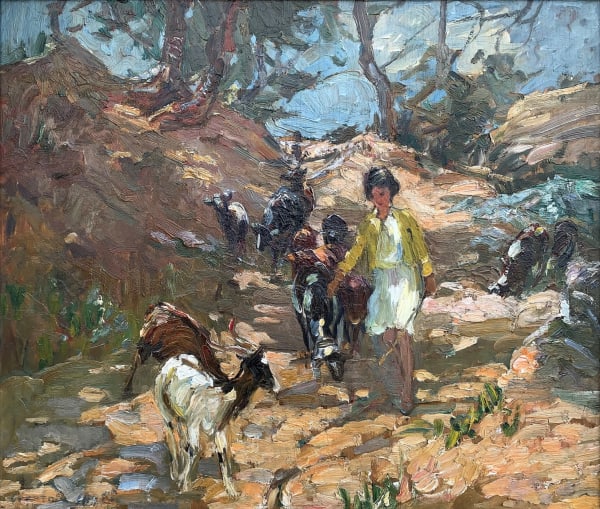
Exploring the Rocks by Dorothea Sharp

Detail of Exploring the Rocks by Dorothea Sharp

Exploring the Rocks by Dorothea Sharp
Dorothea Sharp 1873-1955
Framed 48 x 58 cm (19 x 22¾ ins.)
Further images
Provenance
From the artist's studio to Mr Hillier (from verso note on the panel)Exploring the Rocks is likely painted overlooking St Ives Bay towards the long dune backed beaches stretching from The Towans to Gwithian Beach. Sharp first visited St Ives in 1920, spending much of her summers there throughout the 1920s and 30s and permanently stationing herself there with Marcella Smith for the duration of WW2. The work is a fine example of what Harold Sawkins, the Editor of The Artist Magazine, described when praising Dorothea Sharp in 1935 as ‘one of England’s greatest living woman painters’, and commenting upon the particular appeal of her work: ‘No other woman artist gives us such joyful paintings as she. Full of sunshine and luscious colour, her work is always lively, harmonious and tremendously exhilarating ... the chief attractions of Miss Sharp’s delightful pictures are her happy choice of subjects, and her beautiful colour schemes. Rollicking children bathed in strong sunlight, playing in delightful surroundings, her subjects appeal because they are based on the joy of life”.
In her formative years Dorothea was most profoundly influenced by Clausen, one of the greatest exponents of British Impressionism and an admirer of the French realist, Jules Bastien-Lepage. The dramatic halo effect apparent in Clausen’s work was often adopted by Sharp. Exploring the Rocks is a case in point. Sharp has faced the sun and painted her subjects approaching her, thus creating bright, almost flared edges around them against which darker tones within their forms contrast. Other works which deploy this visual technique are Cornish Holiday, At the water's edge and The Three Sisters, which sold at Sothebys in July 2022 for £47,880.
Dorothea was happiest painting outdoors, or en plein air, on summer mornings and again this piece is a great example. The artist wrote: “These are the days of inspiration. Everywhere there is beauty – flowers blooms in gardens and meadows, the golden sands glitter against emerald and sapphire seas, all Nature is radiant".



